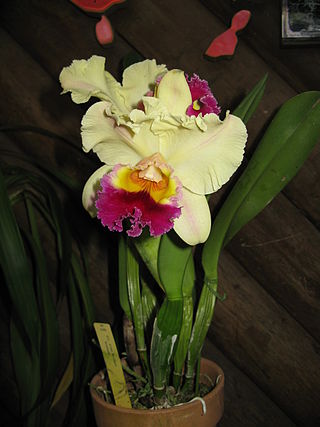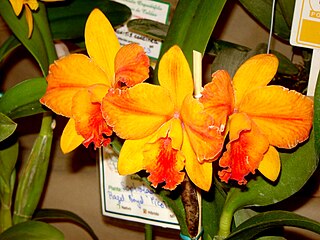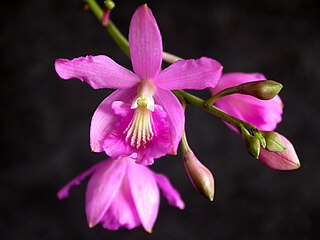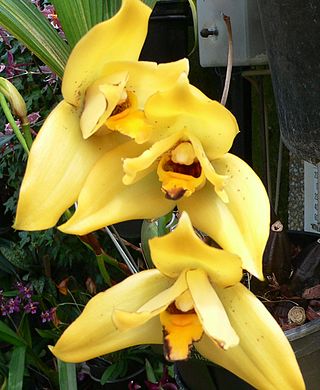
Orchids are plants that belong to the family Orchidaceae, a diverse and widespread group of flowering plants with blooms that are often colourful and fragrant. Orchids are cosmopolitan plants that are found in almost every habitat on Earth except glaciers. The world's richest diversity of orchid genera and species is found in the tropics.

Vanda, abbreviated in the horticultural trade as V., is a genus in the orchid family, Orchidaceae. There are 90 species, and the genus is commonly cultivated for the marketplace. This genus and its allies are considered to be among the most specifically adapted of all orchids within the Orchidaceae. The genus is highly prized in horticulture for its showy, fragrant, long-lasting, and intensely colorful flowers. Vanda species are widespread across East Asia, Southeast Asia, and New Guinea, with a few species extending into Queensland and some of the islands of the western Pacific.

Cymbidium, commonly known as boat orchids, is a genus of evergreen flowering plants in the orchid family Orchidaceae. Orchids in this genus are epiphytic, lithophytic, terrestrial or rarely leafless saprophytic herbs usually with pseudobulbs. There are usually between three and twelve leaves arranged in two ranks on each pseudobulb or shoot and lasting for several years. From one to a large number of flowers are arranged on an unbranched flowering stem arising from the base of the pseudobulb. The sepals and petals are all free from and similar to each other. The labellum is significantly different from the other petals and the sepals and has three lobes. There are about fifty-five species and sixteen further natural hybrids occurring in the wild from tropical and subtropical Asia to Australia. Cymbidiums are well known in horticulture and many cultivars have been developed. The genome of Cymbidium mannii has been sequenced to study epiphytism and crassulacean acid metabolism.

Cattleya is a genus of orchids from Costa Rica south to Argentina. The genus is abbreviated C in trade journals.

Laelia is a small genus of 25 species in the orchid family (Orchidaceae). Laelia species are found in areas of subtropical or temperate climate in Central and South America, but mostly in Mexico. Laelia is abbreviated L. in the horticultural trade.

Encyclia is a genus of orchids. The genus name comes from Greek enkykleomai, referring to the lateral lobes of the lip which encircle the column. It is abbreviated as E. in the horticultural trade.

Rhyncholaelia, abbreviated Rl. in the horticultural trade, is a genus of orchids, comprising two species. They are distributed in Mexico, Guatemala, Belize, and Honduras. Both species were originally published in Brassavola by Lindley. In 1918, Schlechter erected the new genus Rhyncholaelia and moved Brassavola digbyanaLindl. 1846 and Brassavola glaucaLindl. 1839 into it.

Prosthechea is a genus of flowering plants in the orchid family (Orchidaceae). The name is derived from the Greek word prostheke (appendix), referring to the appendage on the back of the column. Appendage orchid is a common name for this genus. Prosthechea is abbreviated Psh. in the horticultural trade.

Leptotes, abbreviated Lpt in horticultural trade, is a genus of orchids formed by nine small species that grow in the dry jungles of south and southeast Brazil, and also in Paraguay or Argentina. They are small epiphytic plants of caespitose growth that sometimes resemble little Brassavola, as they share the same type of thin terete leaves, though they are more closely related to Loefgrenianthus.

× Brassolaeliocattleya, abbreviated Blc. in the horticultural trade, is the orchid nothogenus for intergeneric hybrid greges containing at least one ancestor species from each of the three ancestral genera BrassavolaR.Br., CattleyaLindl. and Laelia Lindl., and from no other genera.

Laeliocattleya is a nothogenus of intergeneric orchid hybrids descended from the parental genera Laelia and Cattleya. It is abbreviated Lc. in the horticultural trade.

× Potinara, abbreviated Pot in the horticultural trade, is the nothogenus comprising those intergeneric hybrids of orchids which have Brassavola, Cattleya, Laelia and Sophronitis as parent genera.

× Sophrolaeliocattleya is a nothogenus of artificial intergeneric orchid hybrids. It is abbreviated as Slc. in the horticultural trade. As of 2008, × Sophrolaeliocattleya is defunct, with the genus Sophronitis having been merged into Cattleya.

Laeliinae is a Neotropical subtribe including 40 orchid genera, such as Brassavola, Laelia and Cattleya. The genus Epidendrum is the largest within this subtribe, containing about 1500 species. This is followed by the genus Encyclia, with over 120 species.

Pseudolaelia is a small genus belonging to the orchid family (Orchidaceae), the entire genus endemic to Brazil. The abbreviation used in the horticultural trade is Pdla.

Holcoglossum (Holc.) is a genus of orchids, in the family Orchidaceae. It is native from Assam through mainland China to Taiwan and Indo-China.

The term grex, derived from the Latin noun grex, gregis, meaning 'flock', has been expanded in botanical nomenclature to describe hybrids of orchids, based solely on their parentage. Grex names are one of the three categories of plant names governed by the International Code of Nomenclature for Cultivated Plants; within a grex the cultivar group category can be used to refer to plants by their shared characteristics, and individual orchid plants can be selected and named as cultivars.
Alex Drum Hawkes (1927–1977) was an American botanist and cookbook author who lived in Coconut Grove, Florida & Kingston, Jamaica. Alex specialized in orchids, bromeliads, palm trees, fruits, vegetables, and nuts. Named the orchid genera Flickingeria, and Paraphalaenopsis and travelled the world extensively, particularly the Caribbean & Latin America during the 1940s - 1970s collecting plants and authentic regional recipes.

Rhyncholaelia digbyana is a species of epiphytic orchid occurring from Honduras to Belize, Guatemala, Mexico and Costa Rica.




























